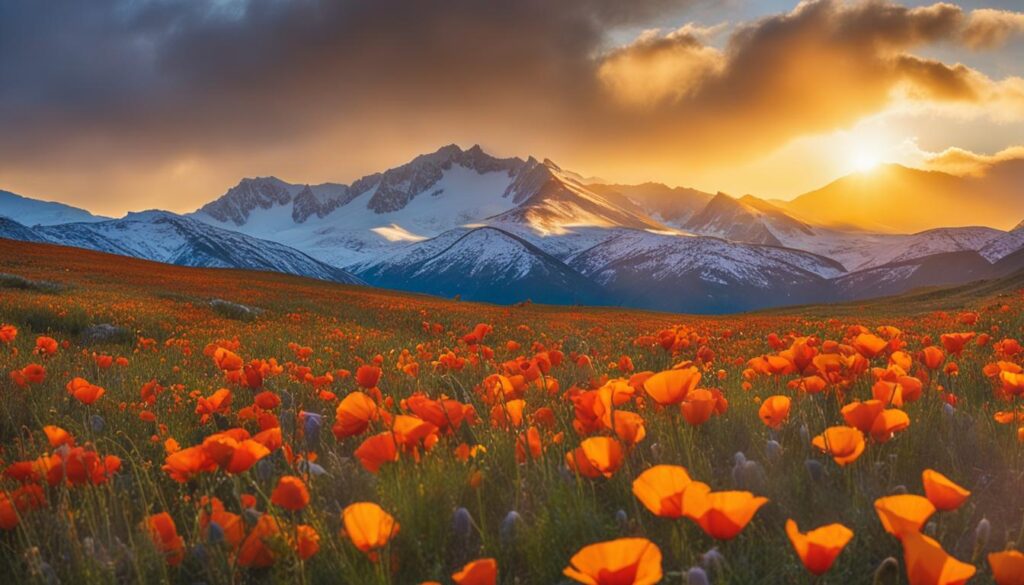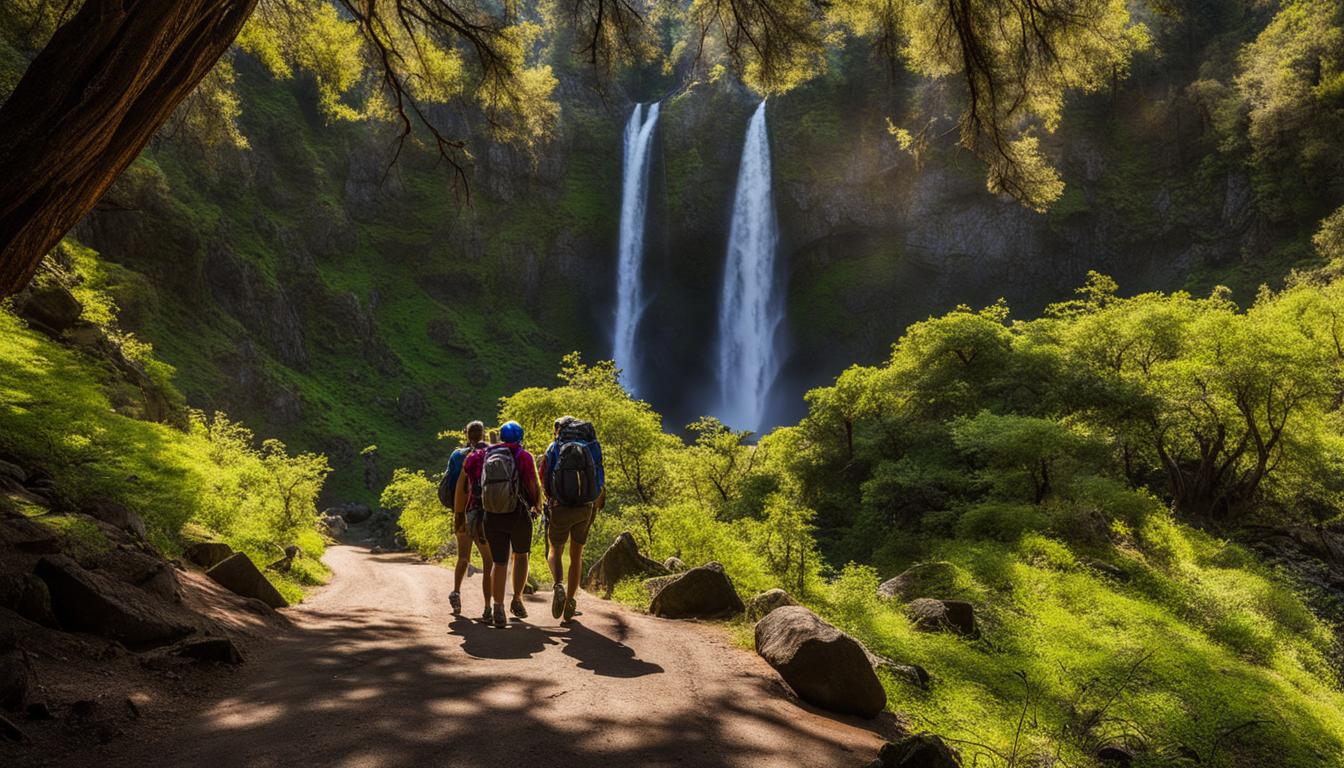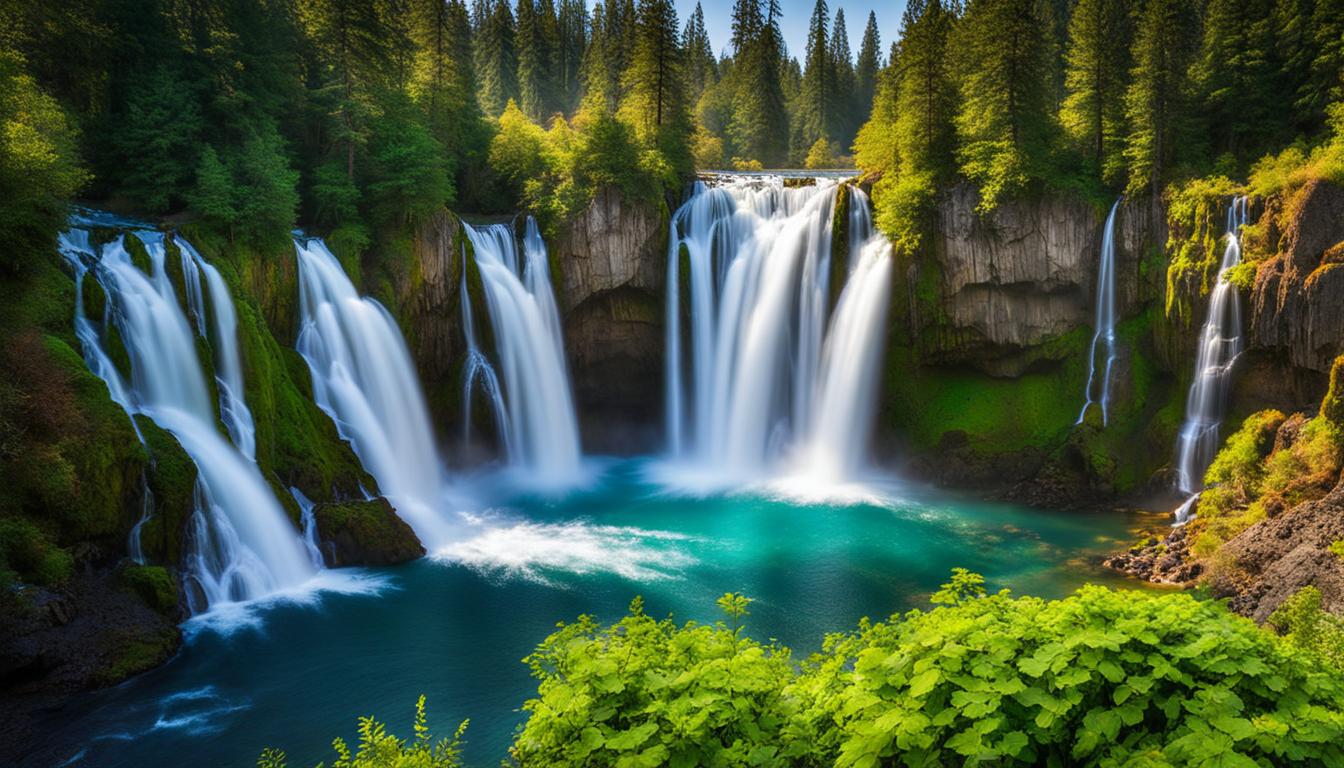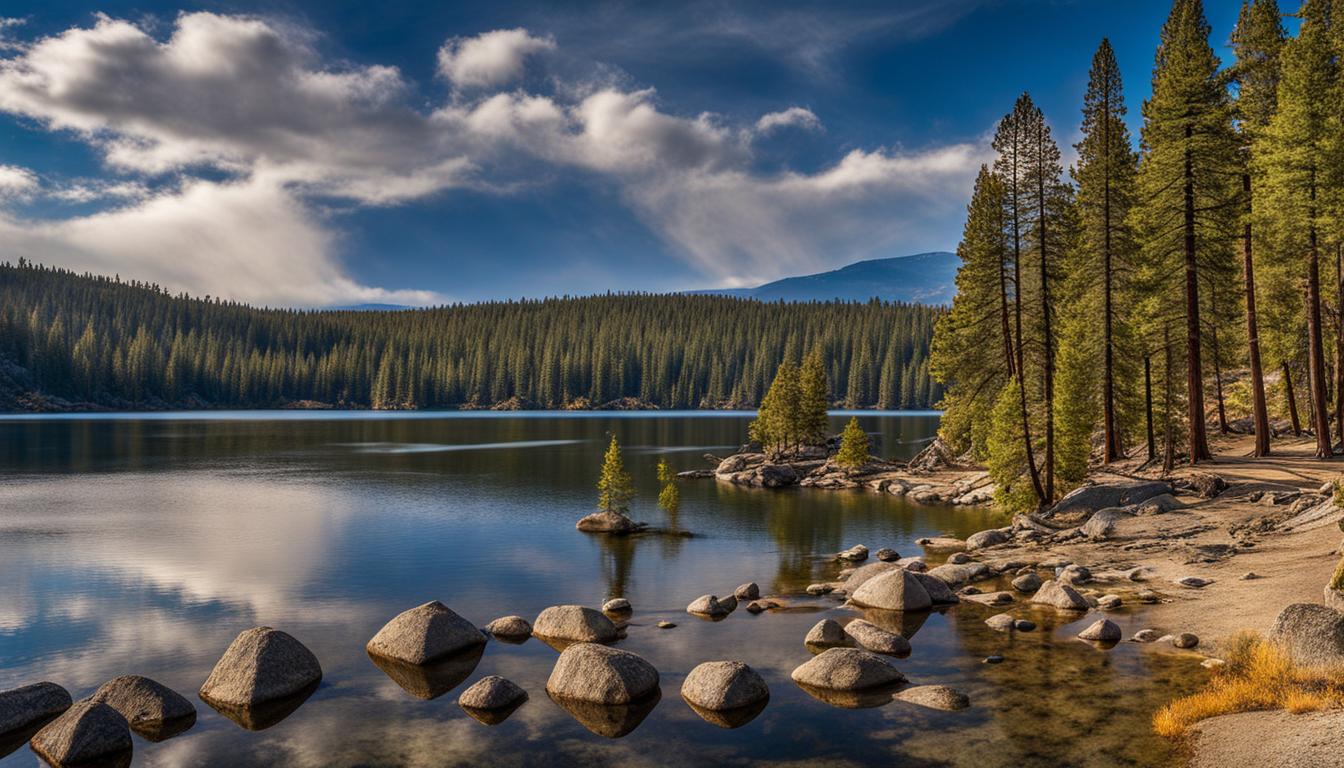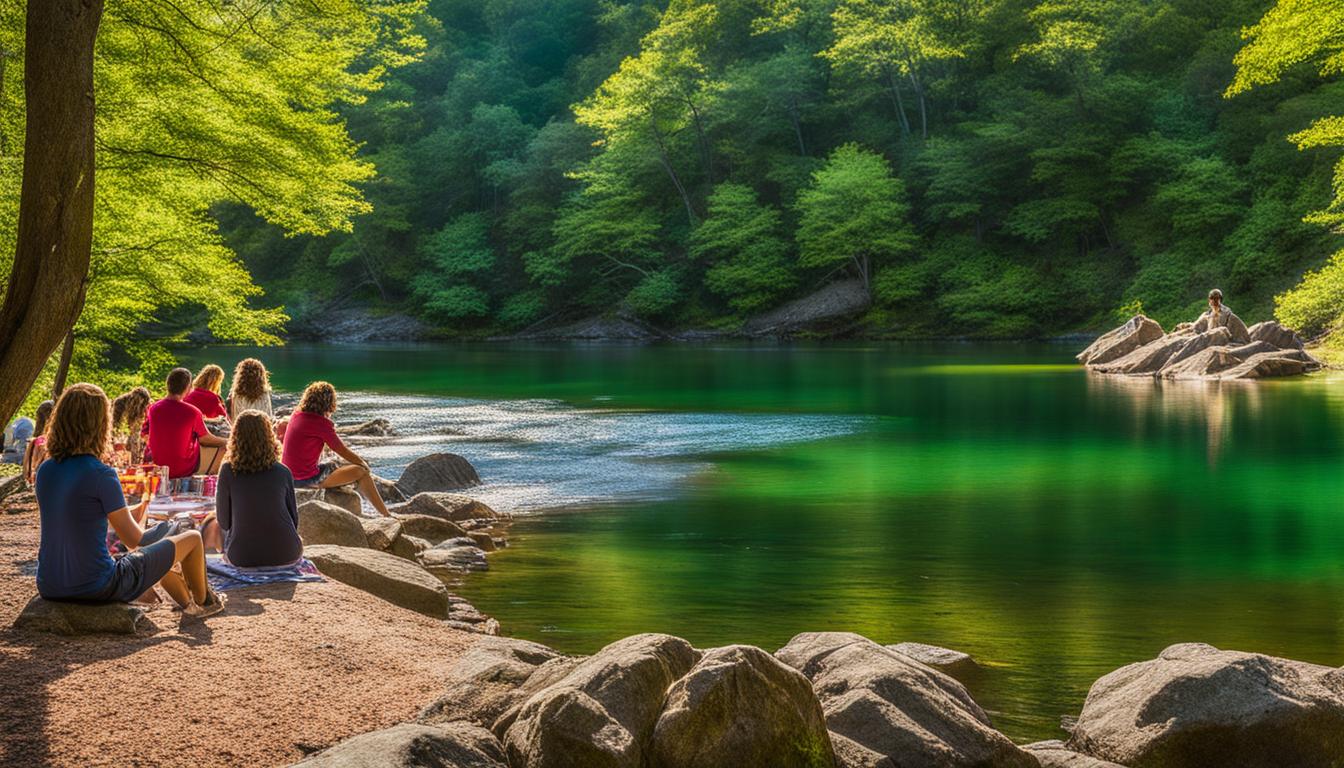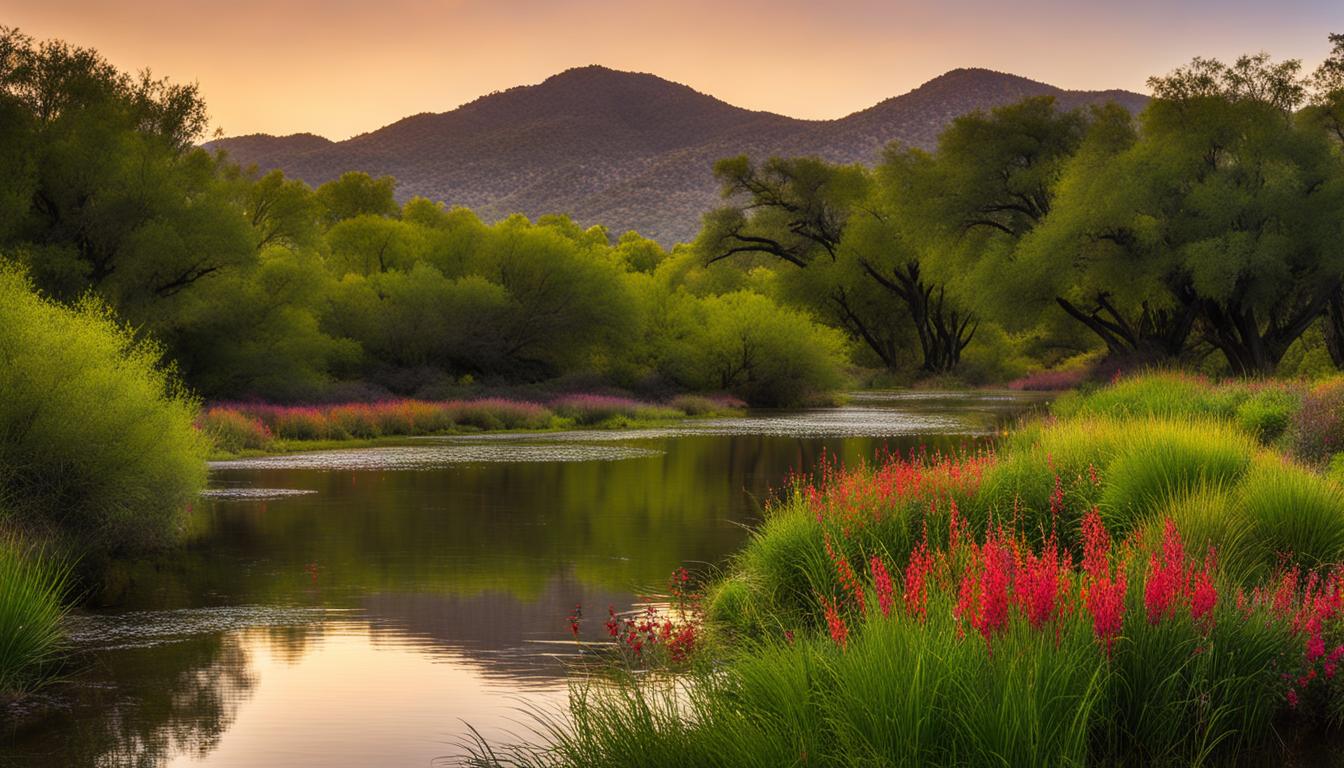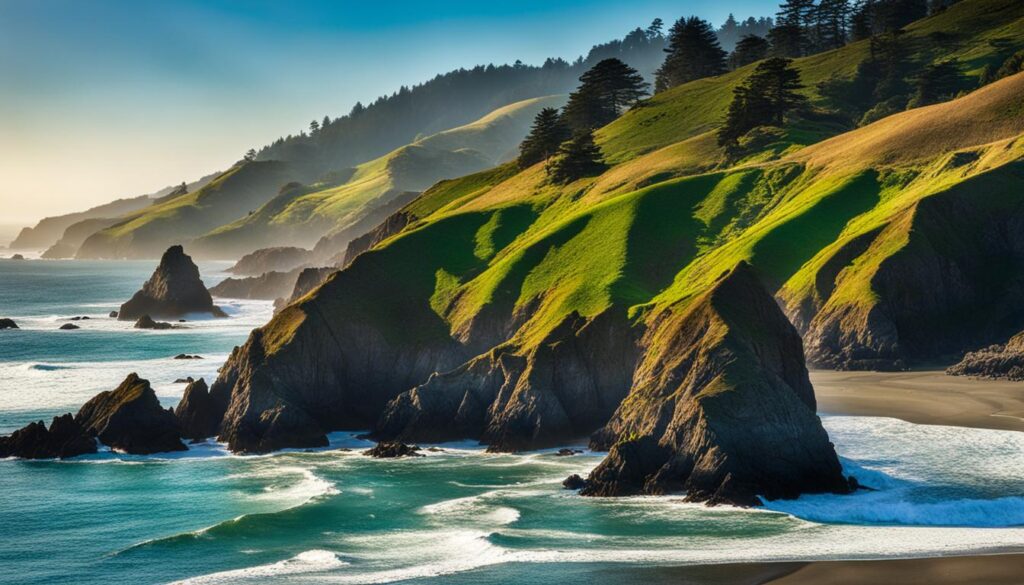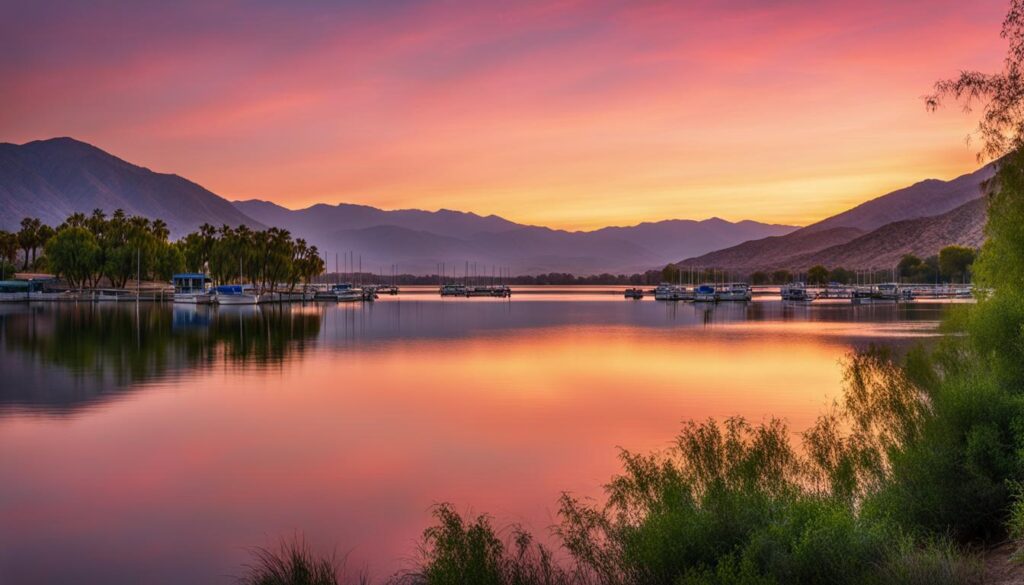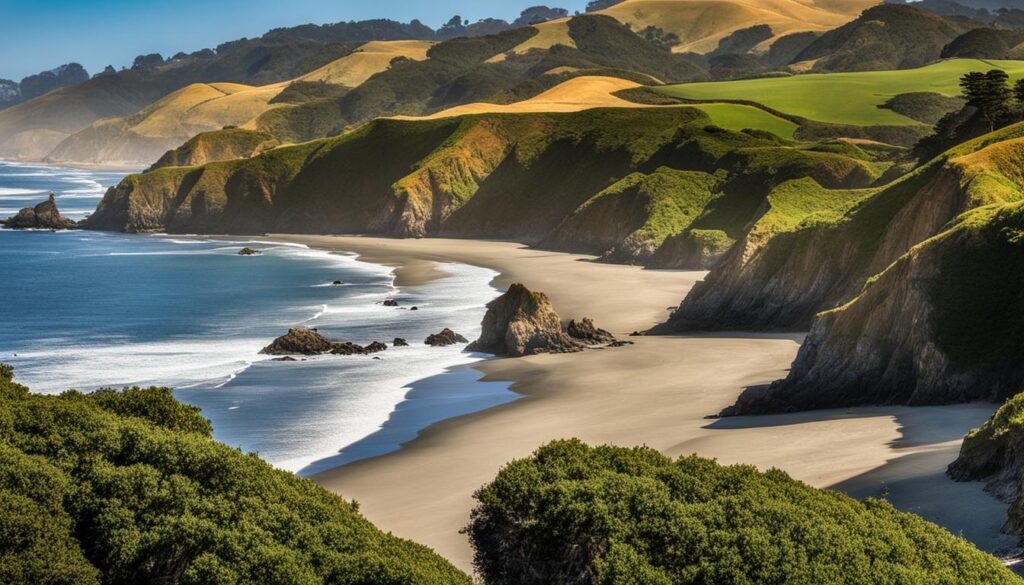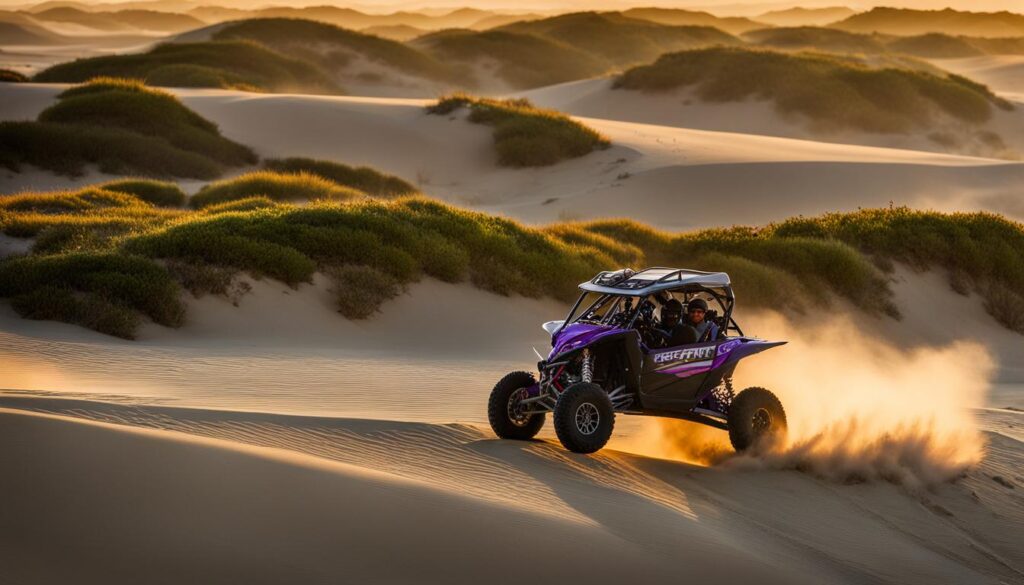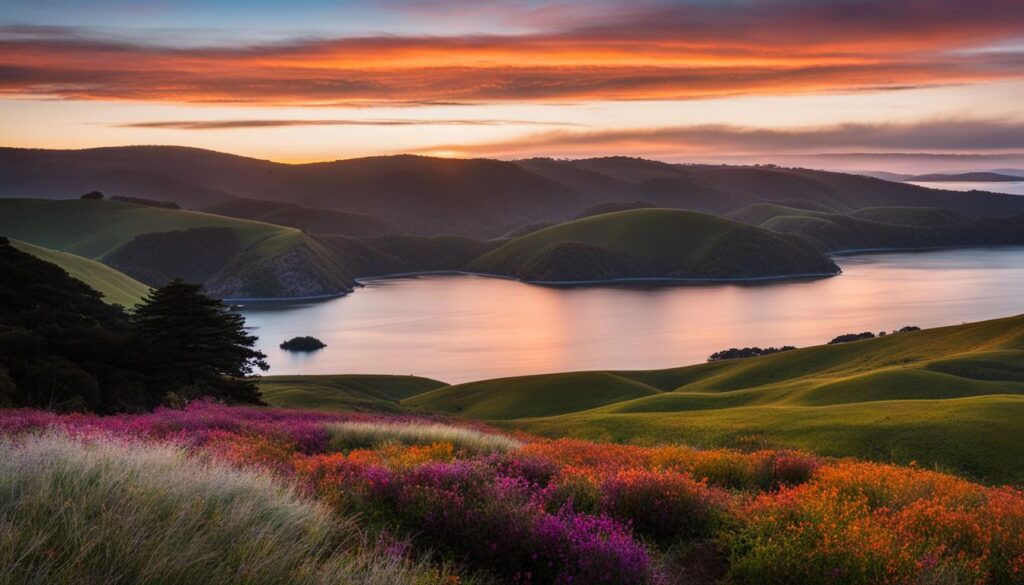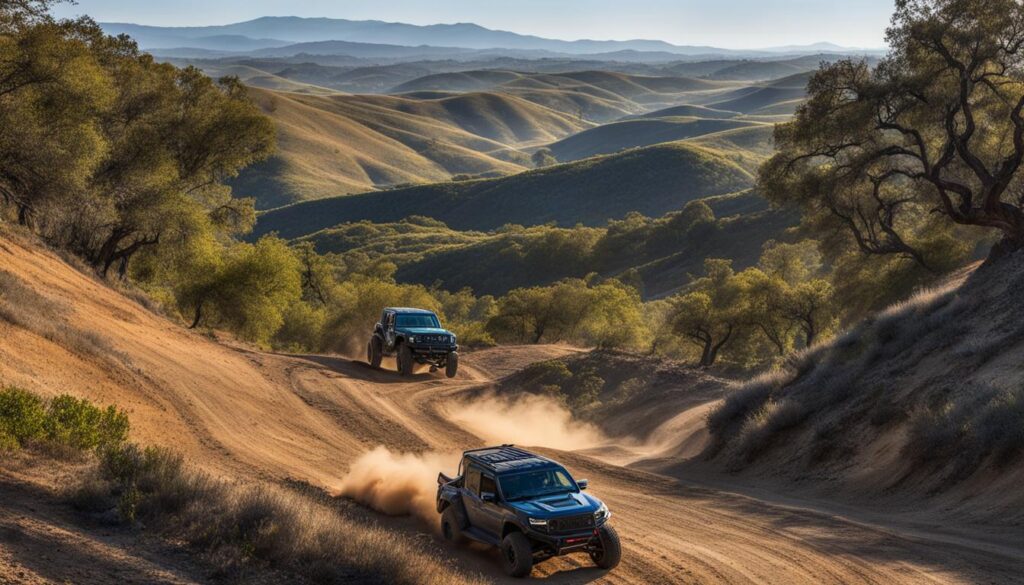Welcome to the Antelope Valley Poppy Reserve, a stunning park nestled in the Mojave Desert Grassland habitat. As you venture into this natural haven, you’ll be greeted by vibrant wildflower blooms, including the iconic California poppies. From mid-February through May, the park transforms into a kaleidoscope of colors and scents, with the landscape changing daily. With eight miles of picturesque trails, the Antelope Valley Poppy Reserve offers an ideal destination for hiking and exploration.
Key Takeaways:
- Antelope Valley Poppy Reserve is located in the Mojave Desert Grassland habitat.
- The park features vibrant wildflower blooms, including the iconic California poppies.
- Wildflower season lasts from mid-February through May, with colors and scents changing daily.
- The park offers eight miles of trails for hiking and exploration.
- Visitors can enjoy the serene countryside, spot wildlife, and relax at picnic areas.
Contents
Essential Information
When planning a visit to the Antelope Valley Poppy Reserve, it is important to have the right information to make the most of your trip. Here are some essential details to help you plan:
Visitor Information
- Spring Season: The park is most popular during the spring season when the wildflowers are in bloom. The best time to visit is usually mid-March through April, but this can vary depending on weather conditions.
- Opening Hours: The Antelope Valley Poppy Reserve is open year-round from sunrise to sunset. It’s important to plan your visit accordingly to ensure you have enough time to explore the park.
- Admission Fees: Admission to the park is $10 per vehicle. There are discounts available for seniors and disabled visitors. It is recommended to bring cash for the entrance fee.
Best Time to Visit
“The Antelope Valley Poppy Reserve is at its most beautiful when the wildflowers are in full bloom during the spring season. Mid-March through April is typically the best time to visit and experience the vibrant colors and fragrant scents of the wildflowers.”
However, it’s important to keep in mind that the bloom can vary from year to year depending on weather conditions. To get the most accurate and up-to-date information on the bloom status, it is recommended to check the park’s Facebook page or call the Wildflower Hotline before your visit.
Additionally, weekdays and early mornings tend to be less crowded, offering a more peaceful experience. If you prefer a quieter visit, consider planning your trip accordingly.
Visitor Guidelines
While visiting the Antelope Valley Poppy Reserve, it’s important to follow the park’s guidelines to ensure the preservation of this unique natural resource:
- Stay on Official Trails: To protect the delicate wildflowers and the park’s ecosystem, it is essential to stay on the designated trails and not venture off into the fields.
- No Picking: Although the temptation may be strong, it is prohibited to pick the wildflowers. Leave them for others to enjoy and help preserve the beauty of the park.
- Leave No Trace: Respect the park and its surroundings by disposing of trash properly and leaving no trace. Help maintain the natural beauty for future visitors.
By following these guidelines and planning your visit during the spring season, you can have a memorable experience exploring the Antelope Valley Poppy Reserve and witnessing the breathtaking display of wildflowers.
Park Highlights

The Antelope Valley Poppy Reserve is renowned for its breathtaking display of poppy fields, attracting visitors from all over the world. The vibrant colors of the California poppies create a stunning visual spectacle that should not be missed. The fields stretch as far as the eye can see, providing a picturesque backdrop for nature enthusiasts and photographers alike.
Miles of Scenic Hiking Trails
The reserve offers a network of hiking trails that wind through the rolling hills, offering visitors a chance to immerse themselves in the beauty of the wildflowers and the surrounding landscape. Whether you’re a seasoned hiker or a casual stroller, there are trails suitable for all skill levels. As you explore the trails, you’ll encounter diverse flora and fauna, adding to the overall experience of the park.
Guided Tours for a Deeper Insight
If you’re looking to delve deeper into the park’s natural wonders and cultural history, guided tours are available. These tours provide a wealth of knowledge and insights from knowledgeable guides who are passionate about the reserve. They will take you on a journey through the park, highlighting the unique features and pointing out the different species of plants and animals that call this habitat home.
| Hiking Trails | Difficulty Level |
|---|---|
| Poppy Trail | Easy |
| Butterfly Trail | Moderate |
| Wildflower Walk | Easy |
Whether you choose to explore the trails on your own or join a guided tour, the park’s highlights are sure to leave a lasting impression. From the vibrant poppy fields to the scenic hiking trails, the Antelope Valley Poppy Reserve offers a truly unforgettable experience for nature lovers and outdoor enthusiasts.
Hiking Trails and Guided Tours
The Antelope Valley Poppy Reserve offers a wide range of activities for visitors to enjoy, including hiking trails and guided tours. The park features eight miles of trails, catering to all skill levels. Whether you’re a beginner or an experienced hiker, there’s a trail for you to explore and admire the stunning wildflower blooms. From paved paths for easy accessibility to unpaved trails for a more adventurous experience, the park’s hiking trails showcase the natural beauty of the reserve.
If you’re interested in learning more about the park’s flora and fauna, guided tours are available. These tours provide an in-depth exploration of the park, offering insights into its natural and cultural history. Led by knowledgeable guides, you’ll discover the secrets of the Antelope Valley Poppy Reserve while enjoying the breathtaking landscapes.
“The guided tour was a fantastic experience. Our guide was extremely knowledgeable and passionate about the park. We learned so much about the wildflowers and the unique ecosystem of the area. Highly recommended!” – Visitor testimonial
Whether you prefer to hike at your own pace or learn from an expert guide, the hiking trails and guided tours at the Antelope Valley Poppy Reserve provide memorable experiences and a deeper understanding of the park’s natural wonders.
| Hiking Trails and Guided Tours | Highlights |
|---|---|
| Eight miles of hiking trails | Stunning views of wildflower blooms |
| Trails suitable for all skill levels | Opportunity to spot local wildlife |
| Guided tours showcasing flora and fauna | In-depth exploration of the park’s history |
Accommodations
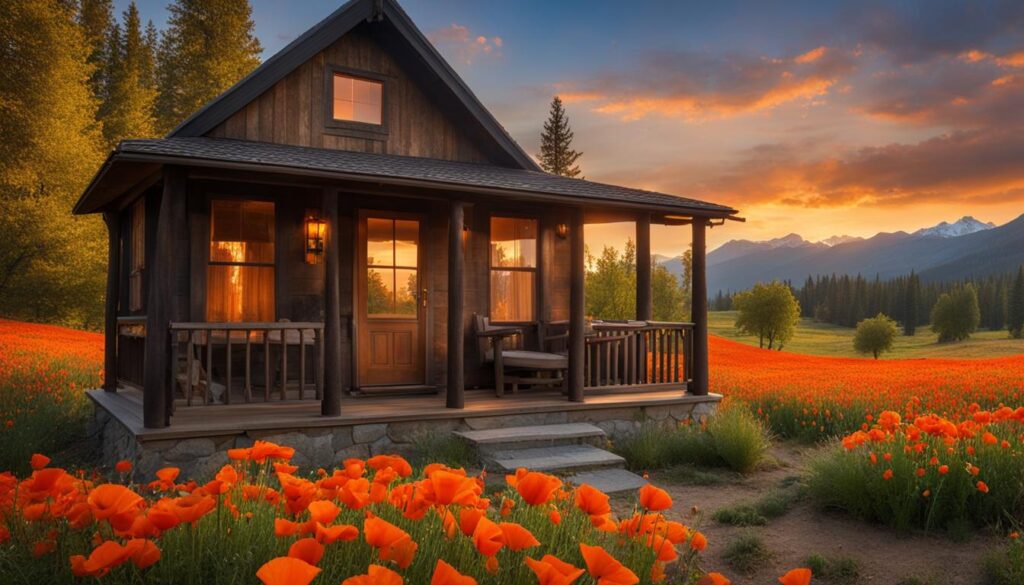
When planning a visit to the Antelope Valley Poppy Reserve, it is important to consider accommodations. While the reserve itself does not offer on-site lodging, there are several options available in the nearby town of Lancaster, located about 15 miles away.
Visitors can choose from a range of hotels, motels, and vacation rentals in Lancaster to suit their preferences and budget. Whether you’re looking for a luxurious stay or a cozy and affordable accommodation, there are plenty of choices available.
It is recommended to book your accommodations in advance, especially during the peak wildflower season, to ensure availability. This will also allow you to plan your visit and make the most of your time at the reserve without worrying about finding a place to stay.
Sample Accommodation Options in Lancaster
| Accommodation | Rating | Price Range |
|---|---|---|
| Lancaster Inn | 3 stars | $80 – $120 per night |
| Desert View Hotel | 4 stars | $120 – $180 per night |
| Cozy Vacation Rental | N/A | $100 – $150 per night |
These are just a few examples of the accommodation options available in Lancaster. Prices may vary depending on the season and availability, so it is recommended to check with the respective hotels or rental agencies for the most up-to-date information.
Exploring the Area
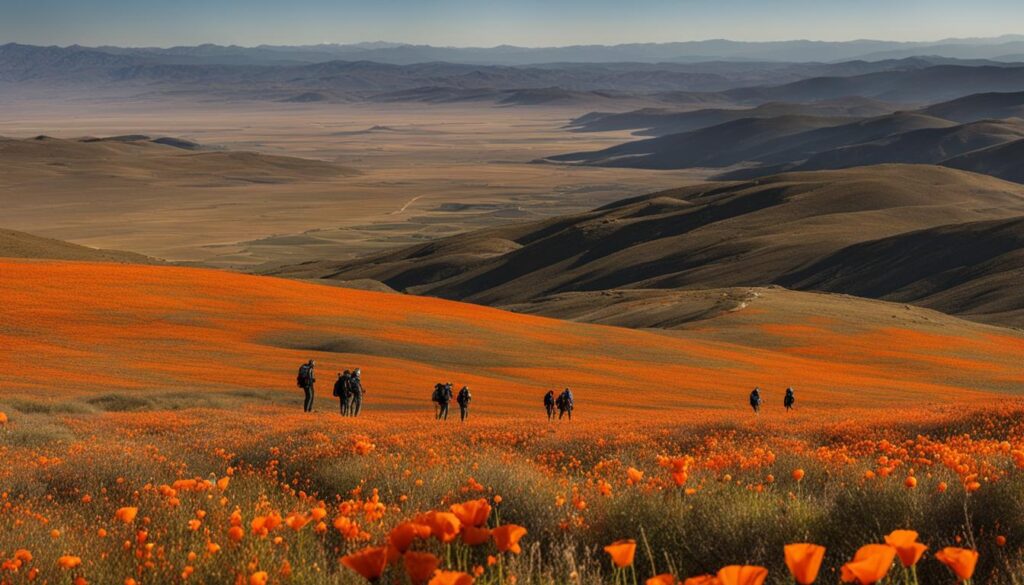
When visiting the Antelope Valley Poppy Reserve, there are other attractions in the area worth exploring. These nearby destinations offer unique experiences and stunning landscapes that complement your visit to the reserve.
Arthur B. Ripley Desert Woodland State Park
Just west of the reserve lies the Arthur B. Ripley Desert Woodland State Park. This park showcases a distinct Joshua Tree and Juniper woodland habitat that is home to a variety of plant and animal species. Explore the trails and witness the beauty of these unique desert trees, while enjoying the peaceful ambiance of the park.
Saddleback Butte State Park
For a different species of wildflowers and a diverse range of outdoor activities, head 32 miles east to Saddleback Butte State Park. This park offers camping, hiking, and picnic areas, allowing you to immerse yourself in the natural beauty of the area. Capture breathtaking views of the desert landscape and enjoy the tranquility of the park’s surroundings.
Red Rock Canyon State Park
If you’re willing to venture a bit further, Red Rock Canyon State Park is located 60 miles north of the Antelope Valley Poppy Reserve. Known for its dramatic colorful cliffs, this park offers a mesmerizing backdrop for camping and hiking adventures. Take in the vibrant hues of the rock formations and marvel at the unique geological features that make this park a hidden gem in the California desert.
| Park | Distance from Antelope Valley Poppy Reserve | Main Highlights |
|---|---|---|
| Arthur B. Ripley Desert Woodland State Park | Located just west of the reserve | Joshua Tree and Juniper woodland habitat |
| Saddleback Butte State Park | 32 miles east of the reserve | Different species of wildflowers, camping, hiking, and picnic areas |
| Red Rock Canyon State Park | 60 miles north of the reserve | Dramatic colorful cliffs, camping, and hiking opportunities |
Services and Facilities

The Antelope Valley Poppy Reserve provides a range of services and facilities to enhance visitors’ experience. Whether you’re a nature enthusiast or a casual visitor, these amenities ensure a comfortable and enjoyable time in the park.
Picnic Areas
One of the highlights of the reserve is the availability of shaded picnic areas. These spots offer a perfect setting to relax and enjoy a meal while surrounded by the breathtaking beauty of the poppy fields. The picnic areas are available on a first-come, first-served basis year-round, so be sure to arrive early to secure a spot.
Visitor Center
“The Jane S. Pinheiro Interpretive Center is a must-visit for anyone interested in learning more about the park’s flora and fauna. The center features informative exhibits on wildflowers and wildlife, an orientation video that provides insights into the park’s history, and a gallery displaying stunning botanical watercolor paintings. Additionally, the visitor center houses a gift shop where you can purchase souvenirs to commemorate your visit.”
Restroom Facilities
No need to worry about bathroom breaks during your visit. The Antelope Valley Poppy Reserve provides restroom facilities conveniently located throughout the park. These facilities are clean, well-maintained, and easily accessible, ensuring that you can freshen up and continue your exploration without any inconvenience.
Park History
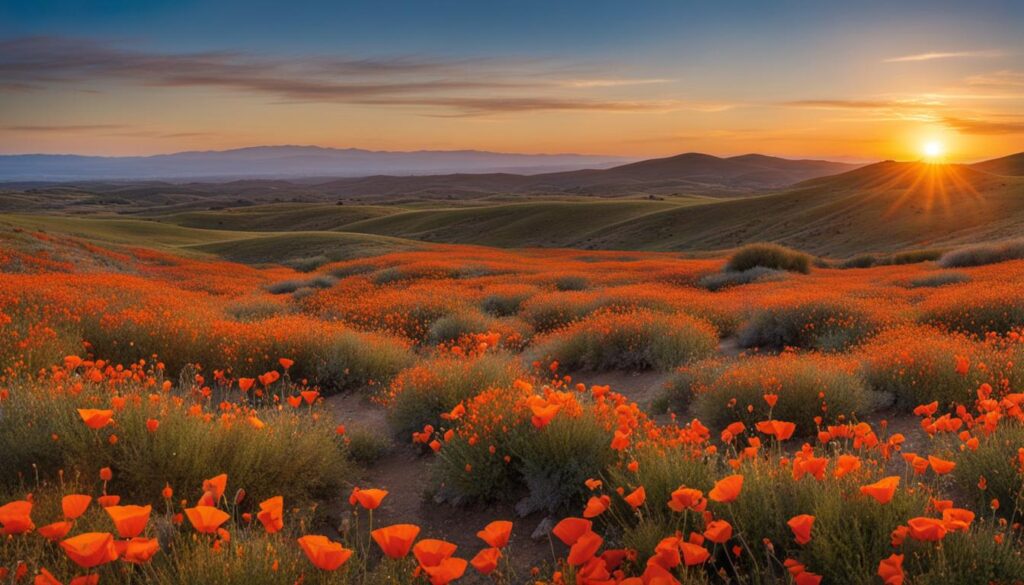
The Antelope Valley Poppy Reserve has a rich history. The park is located on California’s most consistent poppy-bearing land and is part of the state’s efforts to preserve this unique natural resource. Its diverse ecosystem supports a variety of plant and animal species, including the iconic California poppies. The park is influenced solely by natural forces and is not watered or cultivated to stimulate the wildflowers. It stands as a testament to the beauty and fragility of the desert landscape.
Preserving the Natural Beauty
The Antelope Valley Poppy Reserve holds a special place in California’s natural landscape. It showcases the captivating beauty of wildflowers in their natural habitat and serves as a reminder of the importance of conservation efforts. The park’s history is rooted in the preservation and protection of these delicate ecosystems, ensuring that future generations can continue to enjoy their splendor.
“The Antelope Valley Poppy Reserve stands as a testament to the beauty and fragility of the desert landscape.”
A Natural Wonder
The Antelope Valley Poppy Reserve has become a symbol of California’s natural wonders. Its vibrant displays of wildflowers, particularly the California poppy, attract visitors from near and far, eager to witness the breathtaking beauty firsthand. The park’s history reflects a deep appreciation for the natural world and the importance of caring for our environment.
Preserving a Delicate Balance
As visitors explore the Antelope Valley Poppy Reserve, they are reminded of the delicate balance present in the natural world. The park’s history highlights the careful stewardship required to maintain the integrity of these ecosystems. By following the park’s guidelines and respecting its rules, visitors contribute to the ongoing preservation of this remarkable natural treasure.
Planning Your Visit
When planning your visit to the Antelope Valley Poppy Reserve, there are a few factors to consider. The park can get quite crowded during the peak wildflower season, so I recommend visiting on weekdays or early mornings to ensure a more peaceful experience.
It is important to wear comfortable clothing and footwear suitable for hiking, as the park offers eight miles of trails to explore. Don’t forget to bring sunscreen, a hat, and plenty of water, as the desert environment can be challenging, especially during warmer months. Being prepared will help you fully enjoy your time in the park.
Lastly, it is essential to respect the park’s rules and guidelines. Stay on the official trails to protect the delicate ecosystem and wildlife habitats. Remember, picking wildflowers is strictly prohibited, as it disrupts the natural cycle and beauty of the reserve. Let’s all do our part to preserve this precious California gem for future generations.
FAQ
When is the best time to visit the Antelope Valley Poppy Reserve?
The wildflower season typically lasts from mid-February through May, with the colors and scents changing daily. The best time to visit is usually mid-March through April, but this can vary depending on weather conditions. Visitors are encouraged to check the park’s Facebook page or call the Wildflower Hotline for updates on the bloom status.
How much is the admission fee to the park?
Admission to the Antelope Valley Poppy Reserve is $10 per vehicle, with discounts for seniors and disabled visitors.
Can I pick the wildflowers in the park?
It is important to stay on the official trails and not pick the wildflowers while visiting the park. The wildflowers are protected, and picking them is prohibited.
Are guided tours available?
Yes, guided tours are available for groups of 10 or more. These tours provide a deeper insight into the park’s flora and fauna.
Are there accommodations at the Antelope Valley Poppy Reserve?
No, the park does not have on-site accommodations. However, there are several lodging options available in the nearby town of Lancaster, located about 15 miles from the park.
What are some other attractions in the area?
In addition to the Antelope Valley Poppy Reserve, visitors can explore attractions such as Arthur B. Ripley Desert Woodland State Park, Saddleback Butte State Park, and Red Rock Canyon State Park.
What services and facilities are available at the park?
The park offers the Jane S. Pinheiro Interpretive Center, picnic areas, restrooms, and a gift shop. Guided tours and shaded picnic tables are available on a first-come, first-served basis.
What is the history of the Antelope Valley Poppy Reserve?
The park is located on California’s most consistent poppy-bearing land and is part of the state’s efforts to preserve this unique natural resource. It is influenced solely by natural forces and is not watered or cultivated to stimulate the wildflowers.
How should I plan my visit to the Antelope Valley Poppy Reserve?
It is important to consider visiting on weekdays or early mornings to avoid crowds during the peak wildflower season. Visitors should wear comfortable clothing and footwear suitable for hiking, bring sunscreen, a hat, and plenty of water. It is also essential to respect the park’s rules and guidelines.
Source Links
- https://www.visitcalifornia.com/experience/antelope-valley-california-poppy-reserve/
- http://parks.ca.gov/?page_id=627
- https://californiathroughmylens.com/antelope-valley-poppy-reserve/
Check out these other California State Parks:
Check out our northern California guides to find parks near the Bay Area, Grass Valley, Napa and Sacramento. Or our central California guides for parks near Big Sur, Carmel, Gilroy, Pismo Beach or Yosemite. You can also check out these southern California State Parks guides for parks near Palm Springs, San Clemente, San Diego, Santa Barbara or Temecula.
